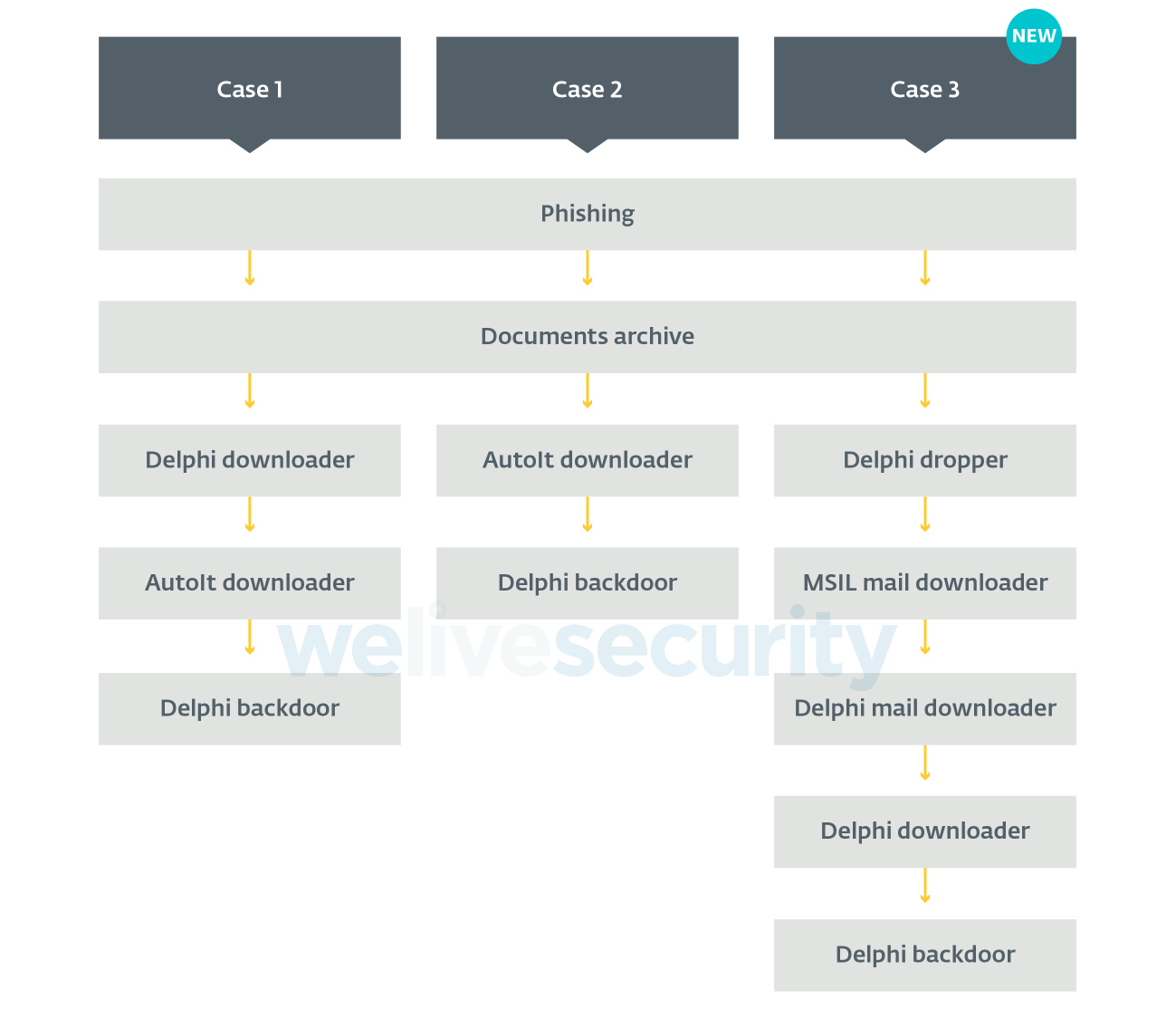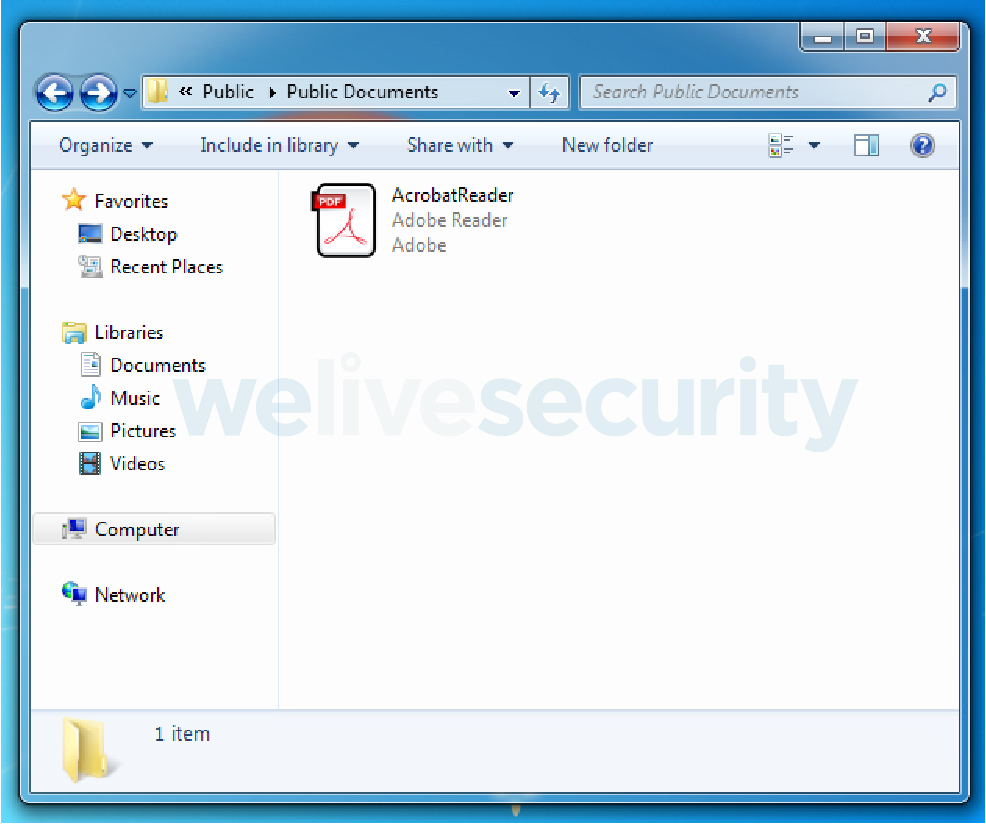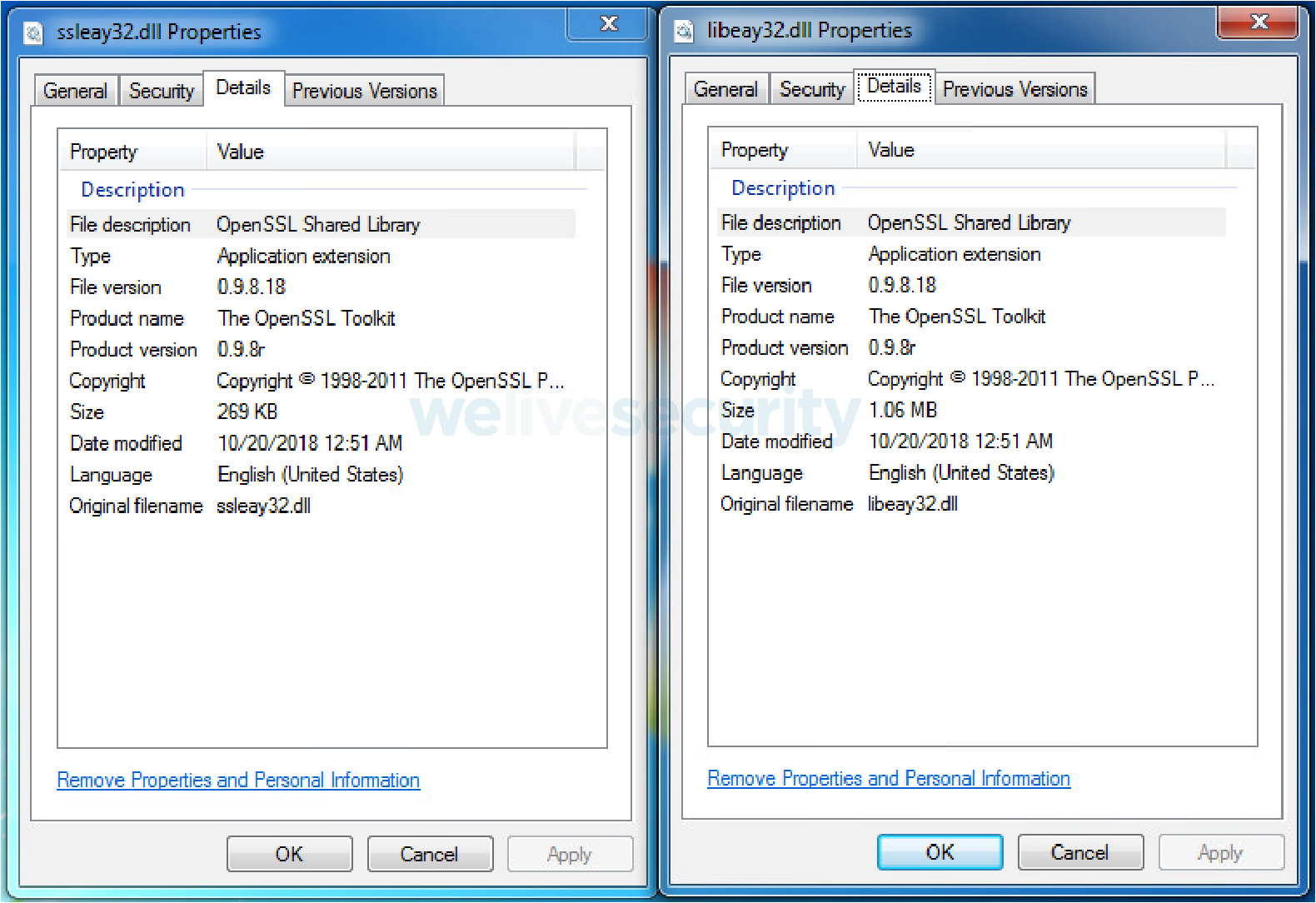The Sednit group has been operating since at least 2004, and has made headlines frequently in past years: it is believed to be behind major, high profile attacks. For instance, the US Department of Justice named the group as being responsible for the Democratic National Committee (DNC) hack just before the US 2016 elections. The group is also presumed to be behind the hacking of global television network TV5Monde, the World Anti-Doping Agency (WADA) email leak, and many others. This group has a diversified set of malware tools in its arsenal, several examples of which we have documented previously in our Sednit white paper from 2016.
Meanwhile, ESET researchers released a whitepaper on LoJax, a UEFI rootkit we attribute to Sednit, used against organizations in the Balkans, and Central and Eastern Europe.
In August 2018, Sednit’s operators deployed two new Zebrocy components, and since then we have seen an uptick in Zebrocy deployments. Zebrocy is a set of downloaders, droppers and backdoors; while downloaders and droppers are doing reconnaissance, backdoors implement persistence and spying activities against the target. These new components use a an unusual way to exfiltrate gathered information by using protocols related to mail services such as SMTP and POP3.
The victims targeted by these new components are similar to victims mentioned in our previous Zebrocy post and by Kaspersky. The targets of such attacks are located in Central Asia, as well as countries in Central and Eastern Europe, notably embassies, ministries of foreign affairs, and diplomats.
The big picture

For two years now, the Sednit group has primarily used phishing emails as the infection vector for Zebrocy campaigns (Case 1 and Case 2). Once the targets have been compromised, they use different first stage downloaders to gather information about the victims and, should the victims be interesting enough, after a delay of several hours – or even days – they deploy one of their second-level backdoors.
The classic modus operandi for a Zebrocy campaign is for the victim to receive an archive attached to an email. This archive contains two files, one a benign document and one an executable. The operator tries to fool the victim by naming the executable with an apparent document or image file name by incorporating the “double extension” trick..
This new campaign, depicted as Case 3 in Figure 1, uses a more involved procedure. We dissect this process below.
Delphi dropper
The first binary is a Delphi dropper, which is kind of unusual for a Zebrocy campaign. Most of the time it’s a downloader rather than a dropper that is installed on the victim system as the first stage.
This dropper contains some tricks to make it more difficult to reverse-engineer. It uses a keyword – liver in the samples we described here – to mark the start and end of key elements as shown below.
$ yara -s tag_yara.yar SCANPASS_QXWEGRFGCVT_323803488900X_jpeg.exe
find_tag SCANPASS_QXWEGRFGCVT_323803488900X_jpeg.exe
0x4c260:$tag: l\x00i\x00v\x00e\x00r\x00
0x6f000:$tag: liver
0x6f020:$tag: liver
0x13ab0c:$tag: liverThe YARA rule above looks for the string liver. The first liver is the one used in the code and it doesn’t separate anything from anything, while the others separate the key descriptor, the image (hexdump below) and the encrypted payload in the dropper.
$ hexdump -Cn 48 -s 0x6f000 SCANPASS_QXWEGRFGCVT_323803488900X_jpeg.exe
0006f000 6c 69 76 65 72 4f 70 65 6e 41 69 72 33 39 30 34 |liverOpenAir3904|
0006f010 35 5f 42 61 79 72 65 6e 5f 4d 75 6e 63 68 65 6e |5_Bayren_Munchen|
0006f020 6c 69 76 65 72 ff d8 ff e0 00 10 4a 46 49 46 00 |liver……JFIF.|
Starting with the image, this is dropped as C:\Users\public\Pictures\scanPassport.jpg if a file of that name does not already exist. Interestingly, the dropper's filename, SCANPASS_QXWEGRFGCVT_323803488900X_jpeg.exe, also hints at a phishing scheme revolving around traveling or passport information. This might indicate that the operator knew the phishing message’s target. The dropper opens the image: if the file exists, it stops executing; otherwise, it drops the image, opens it, and retrieves the key descriptor OpenAir39045_Bayren_Munchen. The image doesn’t seem to display anything while the file format is valid; see Figure 2.

The key descriptor’s string contains Bayren_Munchen which seems likely to refer to the German soccer team FC Bayern Munich. Regardless, it is not the content of the key descriptor – but its length – that matters, with that length used to retrieve the XOR key used to encrypt the payload.
To get the XOR key, the dropper looks for the last liver keyword and adds the offset of the key descriptor. The length of the XOR key – 27 (0x1b) bytes – is the same as that of the key descriptor.
Using the XOR key and a simple XOR loop, the dropper decrypts the last part – which is the encrypted payload – right after the last tag until the end of the file. Notice that the executable payload’s MZ header starts right after the keyword liver and the XOR key retrieved from a part of the PE header that is normally a sequence of 0x00 bytes, which are restored once the payload is decrypted, as seen in Figure 3.

It drops the payload as C:\Users\Public\Documents\AcrobatReader.txt and moves the file to C:\Users\Public\Documents\AcrobatReader.exe
Perhaps this is an attempt to avoid endpoint protection systems triggering an alert based on a binary dropping a file with a .exe extension.
Once again, the operator tries to fool victims in the event that they take a look at the directory, in which case they'll see the file displayed as in Figure 4:

By default, Windows hides the extension, and this is leveraged by the operator to drop an executable in a Documents directory and it makes it look like a PDF file.
Finally, the dropper executes its freshly-dropped payload, and exits.
MSIL mail downloader
The payload of the previous dropper is a UPX-packed MSIL downloader. To make the process easier to understand, the main logic is described below, followed by source code, then an overview of the dissected control flow.
The Main method calls Run to start the application, which then creates the form Form1.
{
Application.EnableVisualStyles();
Application.SetCompatibleTextRenderingDefault(false);
Application.Run((Form) new Form1());
}Form1 initiates a lot of variables, including a new Timer for seven of them.
this.start = new Timer(this.components);
this.inf = new Timer(this.components);
this.txt = new Timer(this.components);
this.subject = new Timer(this.components);
this.run = new Timer(this.components);
this.load = new Timer(this.components);
this.screen = new Timer(this.components);A Timer object has three important fields:
- Enabled: indicates if the timer is active.
- Interval: the time, in milliseconds, between elapsed events.
- Tick: the callback executed when the timer interval has elapsed and the timer is enabled.
Here these fields are initialized as:
this.start.Enabled = true;
this.start.Interval = 120000;
this.start.Tick += new EventHandler(this.start_Tick);
this.inf.Interval = 10000;
this.inf.Tick += new EventHandler(this.inf_Tick);
this.txt.Interval = 120000;
this.txt.Tick += new EventHandler(this.txt_Tick);
this.subject.Interval = 120000;
this.subject.Tick += new EventHandler(this.subject_Tick);
this.run.Interval = 60000;
this.run.Tick += new EventHandler(this.run_Tick);
this.load.Interval = 120000;
this.load.Tick += new EventHandler(this.load_Tick);
this.screen.Interval = 8000;
this.screen.Tick += new EventHandler(this.screen_Tick);For each object, it sets an Interval which is from 8 seconds to 2 minutes. A callback is added to the event handler. Notice that start is the only one that sets Enabled as true, meaning that after 2 minutes (12000 milliseconds = 120 seconds) start_Tick will be called by the event handler.
private void start_Tick(object sender, EventArgs e)
{
try
{
this.start.Enabled = false;
Lenor lenor = new Lenor();
this.dir = !Directory.Exists(this.label15.Text.ToString()) ? this.label16.Text.ToString() + "\" : this.label15.Text.ToString() + "\";
this.att = this.dir + "audev.txt";
this._id = lenor.id(this.dir);
this.inf.Enabled = true;
}Thereafter each method has the same behavior: it sets the Enabled variable to false at the beginning of the method. The method occurs, and afterwards sets the Enabled variable of the next object to true, which will activate the next timer. The Enabled variable is used by the operator to put in place a kind of state machine: if the functions fail, this is a mechanism to repeat failed functions until they succeed. The time between the execution of two functions might be an attempt to evade endpoint protection systems by adding a delay.
Now the structure of each method is defined; the following part will focus on the control flow of the malware.
As the exchanges happen between different email inboxes, here is an overview of the different steps.

One of the early checks made by the malware is for the existence of a specific path used to drop every file used during its execution. If possible, it uses C:\Users\Public\Videos\ -- otherwise it will fall back to C:\Documents and Settings\All Users\Documents\ as its default directory. Notice that the latter path is specific to Windows XP while the former is for Vista and above.
A 16-byte id is generated by concatenating the C: volume serial number and the UserName, and stored in the file audev.txt.
The downloader gathers the following information:
- current path of the application
- operating system version
- system directory
- user domain
- machine name
- UserName
- current time zone
- current date
- logical drive list and information about each of them (model, serial number, etc…)
- directory listing of C:\Program Files\ and C:\Program Files (x86)\
- process list
All this information is stored in the C:\Users\Public\Videos\si.ini file and sent in an email message, as an attachment, via SMTPS, using the default port 465. The email body contains the string SI (which probably stands for System Information), the recipient is sym777.g@post.cz. For all email exchange, the message's Subject: set to the id.
The operator chooses to have multiple fallback addresses and sends the same email to two other, different recipients, presumably in case the main one is not working. Once the email has been sent, the downloader deletes the si.ini file.
For the first execution of the malware, it creates the file set.txt with {System_Parametrs = 10} inside and creates the Windows registry entry:

One screenshot of the victim’s computer is taken under the name scx.bin and sent as an email attachment with SC (which probably stands for Screenshot) in the email’s body.
After dispatch, this malware connects to the kae.mezhnosh@post.cz mailbox via POP3 over SSL (port 995) and looks for messages with a Subject: that corresponds to its own id. If there is such a message and the body is not empty, the malware hex decodes it and then sends a message with okey in the body to sym777.g@post.cz. The content of the email previously retrieved is cleaned and parsed as below:
string[] strArray = this._adr.Replace("B&", "").Replace("Db", "").Split('%');
string str1 = strArray[0];
string str2 = strArray[1];Two strings are obtained: the first one is a password and the second is a username for an email address.
These new credentials are used to connect to the specified inbox freshly collected, and to also look there for a message with a subject that matches the malware’s id as well as an attachment with the string audev in its filename. If both conditions are met, the malware saves the attachment and deletes the message from the server.
All logging messages are sent to sym777.g@post.cz while messages retrieved via POP3 come from credentials recently obtained.
These decisions from the operators make forensics more difficult. First, if you have the downloader with emails, you can’t connect to the mailbox that contains the next stage.
Second, if you retrieve the email credentials, you still can’t get the next payload because it was deleted after retrieval.
Once the downloader successfully writes the attachment to disk, it sends an email with okey2 in the body and an attachment, named l.txt, containing 090. The same file is overwritten with 000 and the malware tries to retrieve another message. Again – if it works – the l.txt file is sent with body text of okey3. The content of the attachment is a directory and a filename. The malware moves the audev file to this filepath. Finally, the malware sends an email with a body message of okey4 and l.txt as attachment. It starts the executable — audev.exe and checks in the list of processes to see if one of them contains the string audev.
Process.Start(this.rn);
foreach (Process process in Process.GetProcesses())
{
if (process.ProcessName.Contains("audev"))
}If a process with such a name is found, it sends a last email with okey5 as the body message and l.txt as the attachment. Finally, it deletes l.txt and set.txt, deletes the Windows registry key it created, and exits.
Delphi mail downloader
The main role of this downloader is to assess the importance of the compromised system and, if it is deemed important enough, to download and execute Zebrocy’s last downloader.
The binary is written in Delphi and packed with UPX. The complete definition of the TForm1 object can be found in its resource section and contains some configuration parameters used by the malware. The following sections focus on the initialization, capabilities, and network protocol of the downloader.
Initialization
At the beginning, it decrypts a bunch of strings that are email addresses and passwords. The operator uses the AES ECB encryption algorithm. Each string is hex-encoded, with the first four bytes corresponding to the final size of the decrypted string (the decrypted strings may contain some padding at the end). There are two AES keys in the TForm1 object; the first one is used to encrypt data while the second is used to decrypt.
Emails and passwords are used by the operator to send commands to the malware and also to retrieve information harvested from the victim’s computer. The communication protocols are SMTP and POP3 – both of them over SSL. To use OpenSSL, the malware drops and uses two OpenSSL dynamic link libraries (DLLs): libeay32.dll (98c348cab0f835d6cf17c3a31cd5811f86c0388b) and ssleay32.dll (6d981d71895581dfb103170486b8614f7f203bdc).

Notice that all files are dropped in the malware’s working directory, C:\Users\Public\
The persistence is done during the first execution of the malware using a well-known technique, the “Logon scripts”. It creates a script file registration.bat and writes several strings from the TForm1 object. The final script is:
reg add HKCU\Environment /v "UserInitMprLogonScript" /t REG_EXPAND_SZ /d "C:\Users\Public\Videos\audev.exe" /f
del C:\Users\Public\Videos\registr.bat
exitLast but not least, the malware creates an id, in the same way as seen in previous Zebrocy binaries. It retrieves the UserName via the GetUserNameW Windows API and prepends the volume serial number of the C:\ drive.
Capabilities
While there are some conditions and order in the execution flow to collect information about the victim, the following section describes different gathering capabilities. The scan configuration is stored in the TForm1 object, grouped under seven different possibilities for retrieving information from the victim’s computer.
Starting with a simple scan, the first information that the malware can collect is related to files with the following extensions: .docx, .xlsx, .pdf, .pptx, .rar, .zip, .jpg, .bmp, .tiff. For each file found on the disk, it retrieves the full path and the last modified date of the file. That information is encrypted using the AES key mentioned earlier and stored in the file 0.txt. Another scan targets the extensions .dat, .json, .db and like the previous scan it retrieves the full path and last modified date of the file. Then it encrypts them and it stores it under the file 57.txt.
Listing running processes is also one of the capabilities of this malware and it stores that information in the 08.txt file, and this looks like the listing below:
======Listing_of_processes=======
[System Process]
System
smss.exe
csrss.exe
wininit.exe
csrss.exe
winlogon.exe
services.exe
lsass.exe
[…]In the file i.txt the malware gathers general information regarding the victim’s computer as well as some information about the malware, like the version number and the path where it’s executed, as shown below:
v7.00
C:\Users\Public\Videos\audev.txt
============================================
Log_Drivers:
C: fixed; size= 102297 Mb, free=83927 Mb S/N: [redacted]
==================================================
OSV: Windows 7
WinType: 32
WinDir: C:\Windows
Lang: English (United States)
TZ: UTC1:0 Romance Standard Time
HostN: [redacted]-PC
User: [redacted]
===============S_LIST=====================
C:\Program Files\Common Files
C:\Program Files\desktop.ini
C:\Program Files\DVD Maker
C:\Program Files\Internet Explorer
C:\Program Files\Microsoft.NET
C:\Program Files\MSBuild
C:\Program Files\Reference Assemblies
C:\Program Files\Uninstall Information
C:\Program Files\Windows Defender
[…]The malware is capable of taking screenshots, which are stored as 2\[YYYY-mm-dd HH-MM-SS]-Image_001.jpg, and generates another file 2\sa.bin, populated with the path listing of all screenshots taken. Its last capability is network enumeration; the output is found as 4.txt.
Network Protocol
The Delphi Mail Downloader is quite a new addition to Zebrocy’s toolset and it features a new way to exfiltrate data and retrieve commands from the operator. The exfiltration is quite simple but very noisy on the network, as all the encrypted files gathered previously are sent over SMTPS and each version of the file is sent three times.
| Sender | Recipient |
|---|---|
| kevin30@ambcomission.com | rishit333@ambcomission.com |
| salah444@ambcomission.com | rishit333@ambcomission.com |
| karakos3232@seznam.cz | antony.miloshevich128@seznam.cz |
The Subject: of the mail is the id of the victim and the file is sent as an attachment with a keyword corresponding to the file content. Notice that for each file there is an encrypted version of the file sent.
| files | files encrypted | keywords |
|---|---|---|
| - | 0.txt | SCAN |
| 57.txt | 58.txt | ACC |
| 08.txt | 082.txt | PrL |
| i.txt | i2.txt | SYS_INFO |
| 4.txt | 42.txt | GET_NETWORK |
Screenshots taken and files matching both scans are sent as well but with different keywords.
| Content | Keywords |
|---|---|
| screenshots | SC |
| .docx, .xlsx, .pdf, .pptx, .rar, .zip, .jpg, .bmp, .tiff | FILEs |
| .dat, .json, .db | D_ACC |

While the exfiltration uses SMTP, the binary connects to the email address tomasso25@ambcomission.com via POP3 and parses emails. The body of the email contains different keywords that are interpreted as commands by the malware.
| Keywords | Purpose | Log |
|---|---|---|
| scan | scan | |
| ldfile | scan | |
| edit34 | execute and delete | |
| pKL90 | register | isreg |
| prlist | process listing | |
| Start23 | execute | isr |
| net40 | enumerating network resources | |
| dele5 | delete file | isd |
| dele6 | delete directory | isd |
| cd25 | create directory | isc |
| autodel | delete itself | |
| Co55 | copy file | is_cp |
| Mo00 | move file | is_m |
Once executed, a debug log and the result of the command, if any, are sent back to the operator. For example, for a scan command, the operator receives a file that contains the list of files matching the scan extensions along with each matching file.
While this downloader has some backdoor features, it drops a Delphi downloader already associated with the group, and described in our previous Zebrocy article.
Summary
In the past, we identified an overlap between Zebrocy and other traditional Sednit malware. We caught Zebrocy dropping XAgent, the Sednit flagship backdoor. Thus, we attribute Zebrocy to the Sednit group with high confidence.
However, the analysis of these binaries shows some mistakes at the language level as well as development decisions that indicate a different maturity in the development of the toolset. Both downloaders are using mail protocols to exfiltrate information and share common mechanisms to gather the same information. Both are also very noisy on the network and on the system, as they create a lot of files and send a lot of them over the network. While analyzing the Delphi mail downloader, some features seem to have disappeared but some strings still remain the binary. Thus, while this toolset is being operated by the Sednit group, we are very confident that it is being developed by a different and less experienced team, as compared to those who develop the traditional Sednit components.
Zebrocy components are fresh add-ons to the Sednit toolset, and the recent events might explain the increasing use of Zebrocy’s binaries rather than the good old Sednit main malware.
Indicators of Compromise (IoCs)
| Filename | SHA-1 | ESET detection |
|---|---|---|
| SCANPASS_QXWEGRFGCVT_323803488900X_jpeg.exe | 7768fd2812ceff05db8f969a7bed1de5615bfc5a | Win32/Sednit.ORQ |
| C:\Users\public\Pictures\scanPassport.jpg | da70c54a8b9fd236793bb2ab3f8a50e6cd37e2df | - |
| C:\Users\Public\Documents\AcrobatReader.{exe,txt} | a225d457c3396e647ffc710cd1edd4c74dc57152 | MSIL/Sednit.D |
| C:\Users\Public\Videos\audev.txt | a659a765536d2099ecbde988d6763028ff92752e | Win32/Sednit.CH |
| %TMP%\Indy0037C632.tmp | 20954fe36388ae8b1174424c8e4996ea2689f747 | Win32/TrojanDownloader.Sednit.CMR |
| %TMP%\Indy01863A21.tmp | e0d8829d2e76e9bb02e3b375981181ae02462c43 | Win32/TrojanDownloader.Sednit.CMQ |
List of emails
| Emails |
|---|
| carl.dolzhek17@post.cz |
| shinina.lezh@post.cz |
| P0tr4h4s7a@post.cz |
| carl.dolzhek17@post.cz |
| sym777.g@post.cz |
| kae.mezhnosh@post.cz |
| tomasso25@ambcomission.com |
| kevin30@ambcomission.com |
| salah444@ambcomission.com |
| karakos3232@seznam.cz |
| rishit333@ambcomission.com |
| antony.miloshevich128@seznam.cz |





